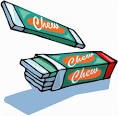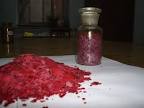Malic acid



pictures of structural formula & malic acid
Basic informations about malic acid:
Generally, marlic acid is an organic acid and olso a compound.
It has a chemical formula of HO2CCH2CHOHCO2H . Which has
a ph value of around 3-5.
Malic acid was first isolated from apple juice by Carl Wilhelm Scheele in 1785.Antoine Lavoisier in 1787 proposed the name acide malique which is derived from the Latin word for apple, mālum.[
Facts about malic acid:
Do you realise that malic acid is used in variety of food?
Some examples are : chewing gums, fruits, deserts, bakery
products, bevarages--- both carbonated & carbonated, hard/
soft candies and last for not least skin & medical care products.



However why is it so? Why is it used in so many variety and types of products?
The reason of malic acid used in variety of products is due to its properties.
Malic acid has:
- a clean, mellow, smooth, persistent sourness,
- flavour enhancement and blending abilities,
- a high solubility rate,
- lower hygroscopicity than Citric or Tartaric acids,
- a lower melting point than other acids for easier incorporation into molten confections,
- and good chelating properties with metal ions.
It forms:
- economical acidulant blends with other acids,
- more soluble calcium salts than Citric acid, and
- effective buffering mixtures.
-Olso it can help to improve Ph stability which is it's unqiue feature.
This is how they are applied to the examples and features of malic acid products I mentioned above:
Hard Candy
Malic acid boosts sourness intensity and enhances fruit flavours. It has a lower melting point than other food acids - this means that it can be incorporated into the molten hard candy without added water - shelf life is increased since the initial moisture level in the hard candy is lower.
Soft Candy
In agar, gelatin or pectin-based candies such as jellies and gummies, Malic acid is used to achieve a natural fruit flavour profile, proper gelling and good product clarity.
Chewing Gum
Organic food acids combined with saccharin improve saliva stimulation in chewing gum. Malic acid is preferred due to its flavour enhancement properties. Using blends of acids with different partition coefficients results in a sequential release of acid - this creates prolonged juiciness and flavour during chewing.

Acid-Based Facial Products
Malic acid, an alpha hydroxy fruit acid, can be used in skin care products to rejuvenate and improve skin conditions.

BAKERY PRODUCTS
Bakery products with fruit fillings (cookies, snack bars, pies, and cakes) have a stronger and more naturally balanced fruit flavour when the fruit filling includes Malic acid. Pectin gel texture is more consistent due to Malic acid's buffering capacity.

MEDICAL AND PERSONAL CARE PRODUCTS
In throat lozenges, cough syrups, and effervescent powdered preparations, Malic acid enhances fruit flavour and can diminish the flavour impact of active components. As Malic acid stimulates saliva flow, it can be used in tooth-cleaning preparations and mouthwashes. Germicidal compounds are used in combination with Malic acid in soaps, mouthwashes, and toothpaste.

BEVERAGES
Carbonated Beverages
Adding Malic acid improves economies, especially in artificially sweetened products. Flavours are enhanced, allowing less flavour to be used, and the overall flavour profile is broader and more natural.
Non-carbonated Beverages
Malic acid is a preferred acidulant for still beverages (fruit drinks, nectars, iced-teas, sports drinks, calcium fortified juices), because it enhances fruit flavours, improves pH stability, and masks the aftertaste of some salts.
Powdered Mixes
In iced tea, sports drink or fruit soup dry mixes, Malic acid is preferred due to its rapid dissolution rate and flavour enhancement qualities. Since Malic acid provides more sourness than Citric acid, less acidulant is required and unit weight can be reduced.

Low Calorie Beverages
In beverages containing intense sweeteners, less Malic acid than Citric is required to achieve the desired sourness and flavour at a higher pH. Malic acid's extended sourness masks sweetener aftertaste (see Taste retention chart) and its blending and fixative abilities give a balanced taste. In a study with 14-30 year olds, aspartame sweetened low-calorie soft drinks acidified with Malic acid were preferred over those with Citric acid.
ESSENTIAL METABOLISM
Malic acid is formed in metabolic cycles in the cells of plants and animals, including humans. For instance, in both the KREB and glyoxalate cycles it provides the cells with energy and carbon skeletons for the formation of amino acids. A relatively large amount of Malic acid is produced and broken down in the human body every day.
Chromic acid

The term chromic acid is usually used for a mixture made by adding concentrated sulfuric acid to a dichromate, which may contain a variety of compounds, including solid chromium trioxide.
Uses
Chromic acid is an intermediate in chromium plating, and is also used in ceramic glazes, and colored glass. Because a solution of chromic acid in sulfuric acid (also known as a sulfochromic mixture orchromosulfuric acid) is a powerful oxidizing agent, it can be used to clean laboratory glassware, particularly of otherwise insoluble organic residues. This application has declined due to environmental concerns
Hexavalent chromium compounds are toxic and carcinogenic. For this reason, chromic acid oxidation is not used on an industrial scale.
Comments (0)
You don't have permission to comment on this page.